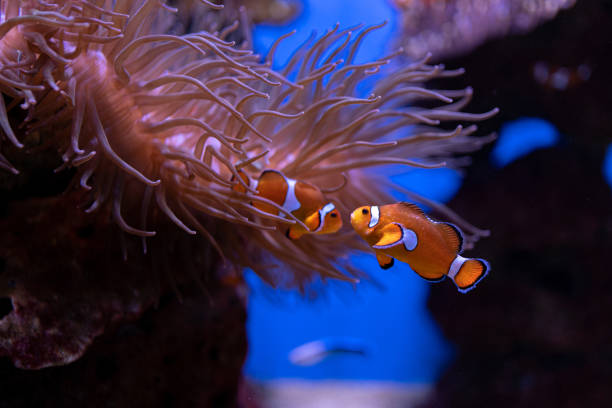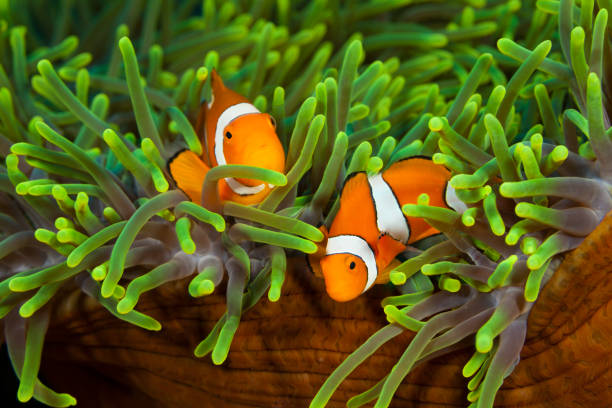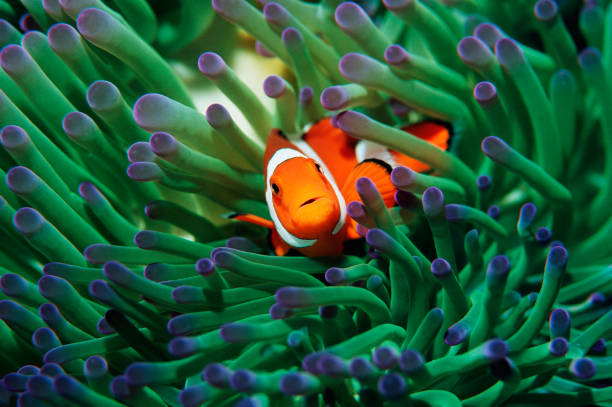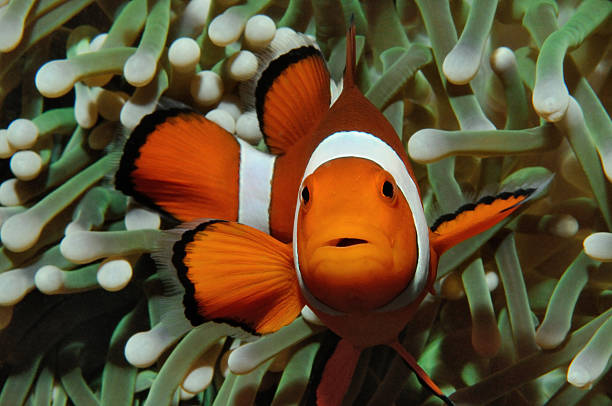Table of Contents
Scientific Classification
| Kingdom | Animalia |
| Phylum | Chordata |
| Class | Actinopterygii |
| Order | Perciformes |
| Family | Pomacentridae |
| Genus | Amphiprion & Premnas |
| Species | Multiple species (e.g., Amphiprion ocellaris, Amphiprion percula) |
| Scientific Name | Varies by species (e.g., Amphiprion ocellaris) |
Description
The anemonefish, commonly known as clownfish, is a small yet striking marine species. Renowned for their vibrant orange hue and distinctive white bands outlined in black, these fish typically reach lengths of 3 to 6 inches, though this can vary by species. Their rounded, flat bodies enable them to swim efficiently. They tend to inhabit areas close to their host anemones. Their playful nature and social interactions contribute to their popularity, especially with the influence of animated films.
Distribution
Clownfish are mainly located in the warm, shallow waters of the Indo-Pacific region. Their habitat extends from the Red Sea and the eastern coast of Africa to Japan, Australia, and the Pacific islands, including the Great Barrier Reef. Unlike many other marine fish, clownfish do not migrate extensively and typically remain close to their host anemone.
Habitat
Clownfish are known for their vibrant colors and unique symbiotic relationship with sea anemones. They primarily inhabit coral reefs and shallow lagoons, thriving in warm waters that range from 75-82°F (24-28°C). The protective tentacles of their host anemones offer both shelter and defense against potential predators. Additionally, clownfish possess a thick layer of mucus on their skin, which grants them immunity to the stinging cells of anemones, called nematocysts. This adaptation is quite rare in the ocean.

Diet
Clownfish are omnivores, which means they consume a variety of both animal and plant-based foods. Their primary diet consists of plankton, algae, small crustaceans, and leftover food from their host anemones. They also help maintain their anemones by eating parasites and bits of dead tentacles, benefiting both species in the process.
Behavior
Clownfish show interesting behaviors. You often see them swimming happily or bouncing in their anemones’ tentacles. They are territorial and form strong bonds with their host anemones. They rarely venture far from them. These fish use popping and clicking sounds to communicate. They do this mainly during territorial fights or mating rituals. Clownfish are different from many marine species. They live in groups with a clear structure. A dominant female leads the school.
Lifespan
Clownfish typically have a lifespan of 6 to 10 years in the wild, but under ideal conditions, some can reach up to 15 years. In captivity, they are protected from predators and environmental threats, which often allows them to live longer, especially with proper care.
Reproduction and Lifecycle
Clownfish have a special way of reproducing called protandry. This means they begin life as males. They can change into females when certain conditions are met. In a group, the dominant fish is always female. If she dies, the largest male changes into a female. Spawning happens on flat surfaces close to their anemones. The female lays hundreds to thousands of eggs there. The male fiercely protects the eggs. He fans them with his fins to keep them oxygenated until they hatch in about a week.

Predators
Clownfish, while benefiting from their protective bond with sea anemones, are not without their natural enemies. Larger fish like groupers, snappers, and lionfish present a serious danger. Additionally, certain species of eels and sharks have been known to hunt them. Nevertheless, their symbiotic relationship with anemones provides substantial defense against many predators.
Adaptations
Clownfish possess several remarkable adaptations that aid their survival:
Bright colors help them blend in with their anemone host. This provides some camouflage.
Hierarchical Social Structure: This system helps the group survive. It allows smooth changes when a dominant fish dies.
Resilient Breeding System: By switching sex when necessary, they maximize their reproductive success.
Conservation Status
Clownfish populations are currently stable, but they face threats from climate change, habitat destruction, and the aquarium trade. Coral reefs are under pressure due to rising sea temperatures and pollution, which impacts the clownfish’s survival by reducing the number of anemone hosts they depend on. Furthermore, excessive collection for aquariums poses a risk to wild populations. Our efforts are focused on breeding these fish in captivity and educating the public about responsible aquarium practices.
The anemonefish, commonly known as clownfish, is an extraordinary marine species that exemplifies the beauty of symbiosis, adaptation, and resilience. Their vibrant colors and fascinating behaviors, along with their crucial role in the ecosystem, make them a true treasure of the ocean. It is essential to protect the habitats of these captivating fish and support conservation initiatives to ensure their safety for future generations.



